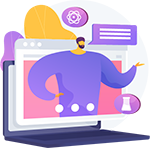Learning ecosystem – collection of people, processes and tools that deliver, integrate and support the L&D function across your organization
From multiple learning portals to Sharepoint portals … from data mining to customer relationship management (CRM) … from HRIS systems … to the all-important content, information is key to success in your organization.
Learning ecosystems is not just a drawing but an implementation roadmap. Let’s take some time to discuss the impact of a learning ecosystem.
Today more than ever, users come to gain information on something. Standalone classroom is no longer the norm. eLearning is somewhat overused and can be underwhelming. Students may know exactly what information they are seeking or a learning curriculum may be assigned to them.
It is not enough to have your users go to a learning management system and view the courses assigned to them. Even using keywords to find courses of interest often fail to find the relevant content. Sound familiar?
YOU ARE NOT ALONE
Learning and development professionals strive to find the perfect mix of quality content. Information is delivered in many shapes and sizes. Content repositories are distributed throughout the enterprise. Traditional LMS systems used to be able to adequately handle the traffic, but that is rapidly changing.

HRIS and Learning Ecosystems
One of the major tasks for HR is to acquire and maintain complex volumes of information that can be further classified, cross checked and retained for future use.
The amount of data stored in a HRIS system is staggering. Payroll, time and attendance management, learning and development, performance and compensation, recruiting and onboarding, workforce planning and HR analytics (data mining) are all important to your ecosystem.
Your HRIS is a key component to your learning ecosystem. First and foremost, it contains all available information about your employees. Many enterprise solutions have default learning and development platforms, but many are not as flexible as we might want them to be. As organizations become more complex and their information management needs increase, the need for relevant information systems also increases dramatically.
For a learner to gather information or training, they must first be identified by the system. Does the user have access to the information they need when they need it? This goes beyond logging in to handle personnel issues. The HRIS system can hold the keys to all that we know about our internal stakeholders.
Many HRIS systems also allow for employees to add information. The richer the employee profile, we are able to offer meaningful learning experiences.
How to extract the information from the HRIS to the ecosystem?
There are multiple ways to integrate this information, but it takes planning and the use of APIs. It is important to select software and technology that can easily communicate with each other.
Joe in Customer Service feels he can better handle customer complaints if he were better at communicating with the customer. He can:
- Ask his manager for advice and/or
- Go to the learning portal and type in some keywords and see what appears
- Choose from the list and begin his training
- Take the information from the training to apply to his customers
- Continue to search for new classes as his confidence grows
But does the system KNOW Joe well enough to offer him suggestions that make sense to Joe’s job description? In many organizations, it is difficult to find training specific to Joe’s immediate needs. An intelligent HRIS system helps L&D identify specific information about Joe so the training platform delivers relevant information only. If Joe is focused on pre-sales customers, his requirements are different than if he is focused on post-sales customers, for example.
The Learning Ecosystem plots the exact information requirements for specific users and job descriptions. It should drill down into departmental objectives and goals. Instancy’s Learning Platform has the intelligence to extract data from the HRIS system. If the learning objects are defined correctly, users are served what they ask for.

The Learning Ecosystem is the Roadmap
The focus of the ecosystem is the learner. To best serve the learner, we must identify as much as we can about them. Technology is only one aspect to consider. Start at the top and move down within the organization.
- Identify key information relative to all employees and courses to offer
- Segment into departments
- Determine the different job descriptions and what training best serves the specific jobs
- At a high level, specify which media is best or available to educate the user
- List what information or courses already available
- Make a list and prioritize the learning ‘must haves’ or ‘nice to have’.
- Keep repeating the process as you continue to plan and build the ecosystem
The HRIS system is the brain or nucleus of the learning platform. The quality of the data information residing in HRIS has a direct impact on the success of the learning ecosystem. The learner must be the focus, how information served to the learner impacts business goals, and the success of the organization is in large part due to the HRIS.
Our next piece will be on CRM and the learning ecosystem. Are there other topics you wish to discuss? Contact us with your feedback. We will include it in a future article.
Why Instancy?
Instancy was built from the ground up with the focus on the learner. The Instancy Platform connects with your HRIS system. It can customize the data extracted from the HR system and use it to personalize the training experience. You can use your favorite software, implement ours, or a combination of both.
We have a successful track record of helping our customers define their learning ecosystem, scope out the desired functionality, and add a level of intelligence to the process. With technology comes risks – let Instancy reduce the risk for you by integrating your learning needs for you.
Do good work!
Harvey




